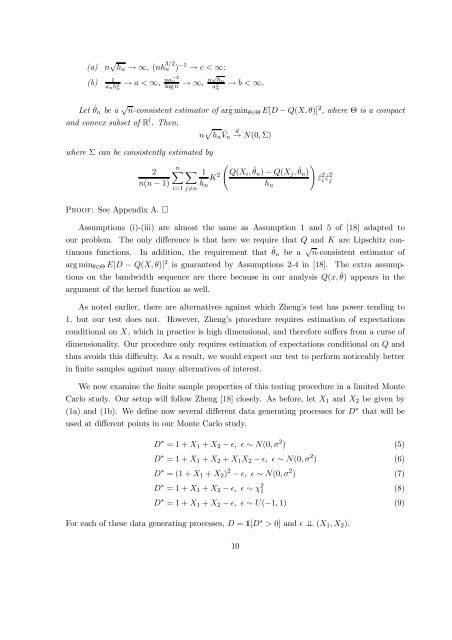On the Identification of Misspecified Propensity Scores - School of ...
On the Identification of Misspecified Propensity Scores - School of ...
On the Identification of Misspecified Propensity Scores - School of ...
You also want an ePaper? Increase the reach of your titles
YUMPU automatically turns print PDFs into web optimized ePapers that Google loves.
(a) n √ hn → ∞, (nh 3/2<br />
n ) −1 → c < ∞;<br />
(b)<br />
1<br />
anh 2 n<br />
→ a < ∞, na−2 n<br />
log n → ∞, n√hn a2 n<br />
→ b < ∞.<br />
Let ˆ θn be a √ n-consistent estimator <strong>of</strong> arg minθ∈Θ E[D − Q(X, θ)] 2 , where Θ is a compact<br />
and convex subset <strong>of</strong> R l . Then,<br />
hn<br />
i=1 j=n<br />
n hn ˆVn d → N(0, Σ)<br />
where Σ can be consistently estimated by<br />
n 2 <br />
n(n − 1)<br />
1<br />
K 2<br />
<br />
Q(Xi, ˆ θn) − Q(Xj, ˆ <br />
θn)<br />
P: See Appendix A. <br />
Assumptions (i)-(iii) are almost <strong>the</strong> same as Assumption 1 and 5 <strong>of</strong> [18] adapted to<br />
our problem. The only difference is that here we require that Q and K are Lipschitz con-<br />
tinuous functions. In addition, <strong>the</strong> requirement that ˆ θn be a √ n-consistent estimator <strong>of</strong><br />
arg minθ∈Θ E[D − Q(X, θ)] 2 is guaranteed by Assumptions 2-4 in [18]. The extra assump-<br />
tions on <strong>the</strong> bandwidth sequence are <strong>the</strong>re because in our analysis Q(x, ˆ θ) appears in <strong>the</strong><br />
argument <strong>of</strong> <strong>the</strong> kernel function as well.<br />
As noted earlier, <strong>the</strong>re are alternatives against which Zheng’s test has power tending to<br />
1, but our test does not. However, Zheng’s procedure requires estimation <strong>of</strong> expectations<br />
conditional on X, which in practice is high dimensional, and <strong>the</strong>refore suffers from a curse <strong>of</strong><br />
dimensionality. Our procedure only requires estimation <strong>of</strong> expectations conditional on Q and<br />
thus avoids this difficulty. As a result, we would expect our test to perform noticeably better<br />
in finite samples against many alternatives <strong>of</strong> interest.<br />
We now examine <strong>the</strong> finite sample properties <strong>of</strong> this testing procedure in a limited Monte<br />
Carlo study. Our setup will follow Zheng [18] closely. As before, let X1 and X2 be given by<br />
(1a) and (1b). We define now several different data generating processes for D ∗ that will be<br />
used at different points in our Monte Carlo study.<br />
hn<br />
ˆε 2 i ˆε 2 j<br />
D ∗ = 1 + X1 + X2 − ǫ, ǫ ∼ N(0, σ 2 ) (5)<br />
D ∗ = 1 + X1 + X2 + X1X2 − ǫ, ǫ ∼ N(0, σ 2 ) (6)<br />
D ∗ = (1 + X1 + X2) 2 − ǫ, ǫ ∼ N(0, σ 2 ) (7)<br />
D ∗ = 1 + X1 + X2 − ǫ, ǫ ∼ χ 2 1<br />
D ∗ = 1 + X1 + X2 − ǫ, ǫ ∼ U(−1, 1) (9)<br />
For each <strong>of</strong> <strong>the</strong>se data generating processes, D = 1[D ∗ > 0] and ǫ ⊥ (X1, X2).<br />
10<br />
(8)
















